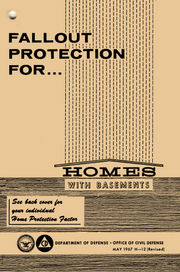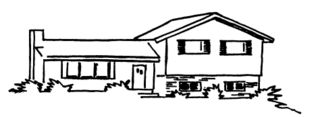Difference between revisions of "Fallout Protection For Homes With Basements"
AzraelBrown (talk | contribs) |
AzraelBrown (talk | contribs) |
||
| Line 1: | Line 1: | ||
[[Image:Frontcover-med.jpg|right|180px]][[Fallout Protection For Homes With Basements]] is a 28-page pamphlet produced by the U.S Government during the Cold War, providing tips and instructions on how to harden an existing basement against radiation and fallout resulting from a nuclear explosion. | [[Image:Frontcover-med.jpg|right|180px]][[Fallout Protection For Homes With Basements]] is a 28-page pamphlet produced by the U.S Government during the Cold War, providing tips and instructions on how to harden an existing basement against radiation and fallout resulting from a nuclear explosion. | ||
| − | + | ||
| + | [http://www.lulu.com/content/2178770 You can purchase a reprint edition from The Infomercantile at our LuLu.com Store]. | ||
| + | |||
==Book Contents== | ==Book Contents== | ||
| Line 22: | Line 24: | ||
Radiation would come from the fallout wherever it settled -- the ground, trees and bushes, or the roof of your home. ''Fallout does not behave like a gas.'' In areas that would be affected by dangerous amounts of fallout, the fallout particles would look like dirt or hand and you may see them after they have settled on the ground or other places. The exact amount of radiation given off by the particles can be measured only by special instruments. | Radiation would come from the fallout wherever it settled -- the ground, trees and bushes, or the roof of your home. ''Fallout does not behave like a gas.'' In areas that would be affected by dangerous amounts of fallout, the fallout particles would look like dirt or hand and you may see them after they have settled on the ground or other places. The exact amount of radiation given off by the particles can be measured only by special instruments. | ||
| + | |||
| + | ===HOW CAN YOUR PROTECTION BE IMPROVED?=== | ||
| + | |||
| + | There are three ways of improving your protection against fallout -- time, distance, and getting some heavy material between you and the fallout (called "shielding"). | ||
| + | |||
| + | [[Image:Fallout_Protection_For_Homes_With_Basements-Illustration_3.jpg|60px|left]]1. ''Time'' -- Radioactivity decreases rapidly at first. After an attach, the radiation would be most intense during the first few days. Even so, radiation protection may be needed for an extended period -- days or weeks. | ||
| + | |||
| + | 2. ''Distance'' -- The amount of radiation is less the further away you are from the source of radiation. | ||
| + | |||
| + | 3. ''Shielding''--Any material that is put between a person and the source of radiation cuts down on the amount of radiation that reaches the person. The thicker and heavier the material, the better the protection. | ||
| + | |||
| + | In the event of an attach, you have little control over time and distance, but YOU CAN DO SOMETHING TO IMPROVE YOUR PROTECTION BY MEANS OF SHIELDING. | ||
| + | |||
| + | It is the principle of shielding that is employed in fallout shelters. Under the guidance of the Office of Civil Defense, a system of fallout shelters is being developed throughout the nation. It consists of public shelters, private shelters, industrial and home shelters. | ||
Revision as of 23:45, 10 March 2008
Fallout Protection For Homes With Basements is a 28-page pamphlet produced by the U.S Government during the Cold War, providing tips and instructions on how to harden an existing basement against radiation and fallout resulting from a nuclear explosion.
You can purchase a reprint edition from The Infomercantile at our LuLu.com Store.
Contents
Book Contents
THE FALLOUT PROTECTION IN YOUR HOME
This booklet is about fallout protection. It will tell you what radioactive fallout is and how you can improve your protection against it if this country were ever attacked with nuclear weapons. But first of all, because your home has a basement you already have some fallout protection. Let's see what that protection is:
On the back cover of this booklet a box like this appears:
Entered in the space labeled Basement "PF" are two numbers which tell you the fallout protection that was calculated for the "center" of your basement and the "best corner" of your basement. Information on the box labeled "Added Weight", is on page 20 of this booklet.
The "PF" above the box stands for "Protection Factor." Before going into the details of what your "Protection Factor" numbers mean, let's talk for a moment about what fallout is.
WHAT IS RADIOACTIVE FALLOUT?
When a nuclear weapon is exploded close to the ground, dirt and other debris are drawn up into the mushroom cloud and pick up the radioactivity created by the explosion. The heaviest pieces of dirt and debris drop back to earth within a few miles of the explosion. But the lighter pieces are carried by the winds for many miles before drifting back to earth.
These radioactive particles are called "fallout." Any part of the United States might be covered with deadly or dangerous amounts of radioactive fallout, depending on which way the winds were blowing and the size and number of nuclear weapons exploded. The radioactivity could cause serious health damage or fatal injury to unprotected persons. In a nuclear attack, the blast, heat, and fire from the explosions would be very destructive, but the destruction would be in areas near the explosions. Radioactive fallout, though, could spread a thin layer over millions of square miles.
Radiation would come from the fallout wherever it settled -- the ground, trees and bushes, or the roof of your home. Fallout does not behave like a gas. In areas that would be affected by dangerous amounts of fallout, the fallout particles would look like dirt or hand and you may see them after they have settled on the ground or other places. The exact amount of radiation given off by the particles can be measured only by special instruments.
HOW CAN YOUR PROTECTION BE IMPROVED?
There are three ways of improving your protection against fallout -- time, distance, and getting some heavy material between you and the fallout (called "shielding").
1. Time -- Radioactivity decreases rapidly at first. After an attach, the radiation would be most intense during the first few days. Even so, radiation protection may be needed for an extended period -- days or weeks.
2. Distance -- The amount of radiation is less the further away you are from the source of radiation.
3. Shielding--Any material that is put between a person and the source of radiation cuts down on the amount of radiation that reaches the person. The thicker and heavier the material, the better the protection.
In the event of an attach, you have little control over time and distance, but YOU CAN DO SOMETHING TO IMPROVE YOUR PROTECTION BY MEANS OF SHIELDING.
It is the principle of shielding that is employed in fallout shelters. Under the guidance of the Office of Civil Defense, a system of fallout shelters is being developed throughout the nation. It consists of public shelters, private shelters, industrial and home shelters.



